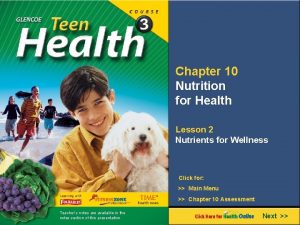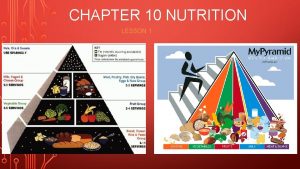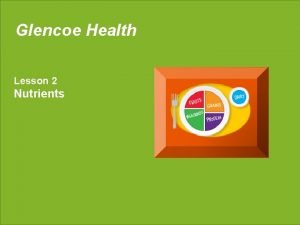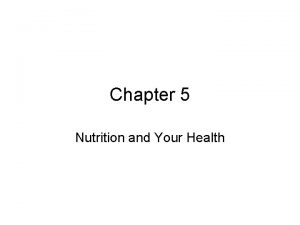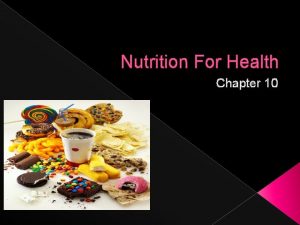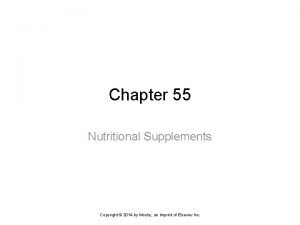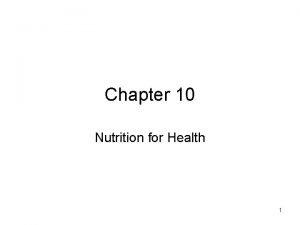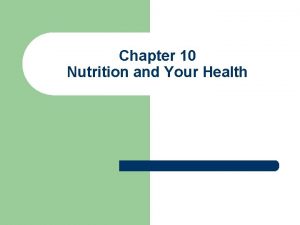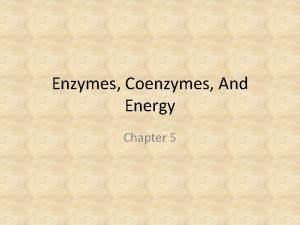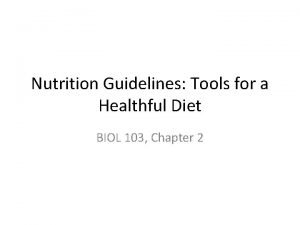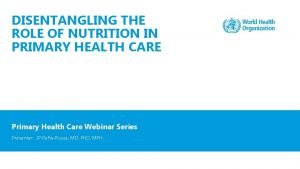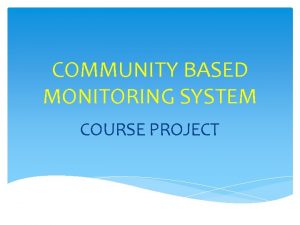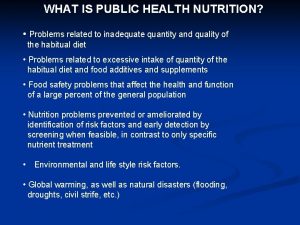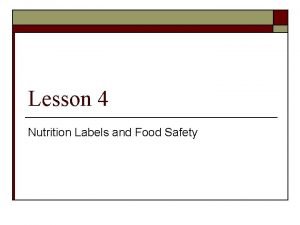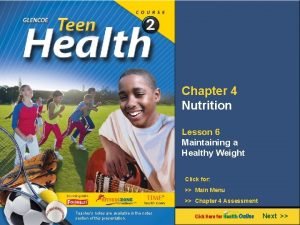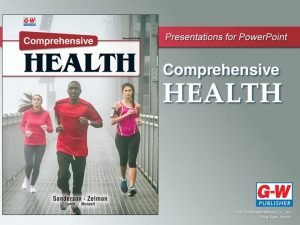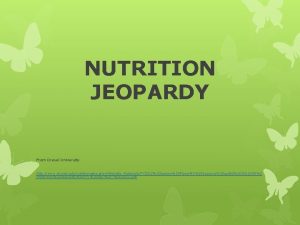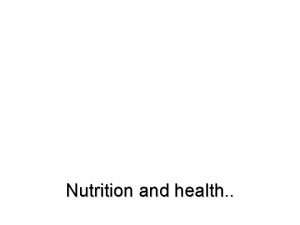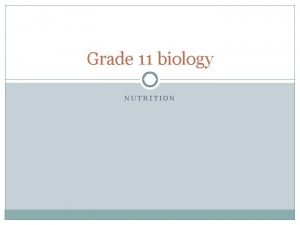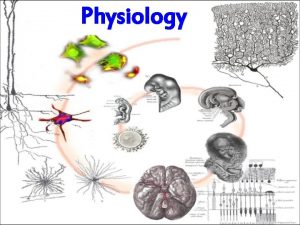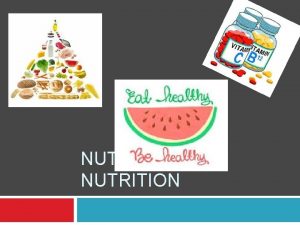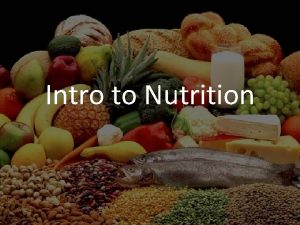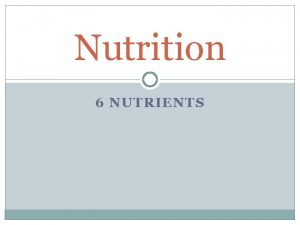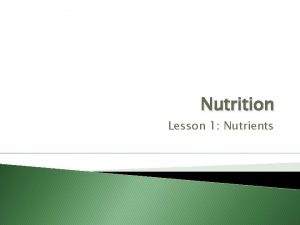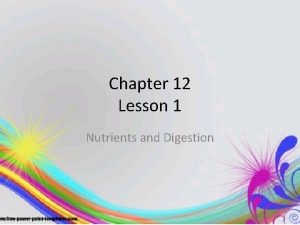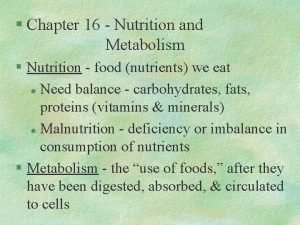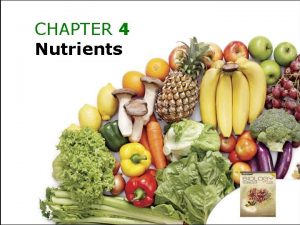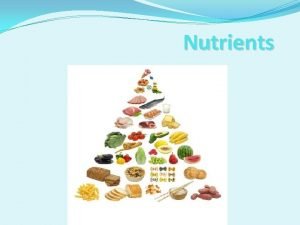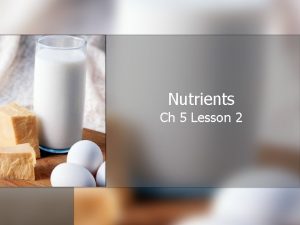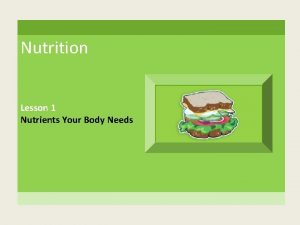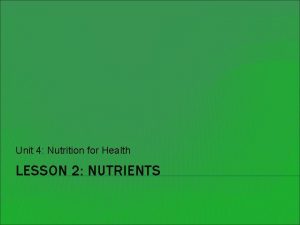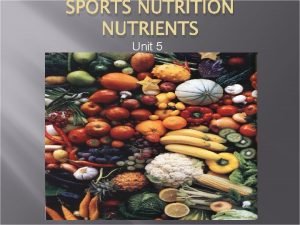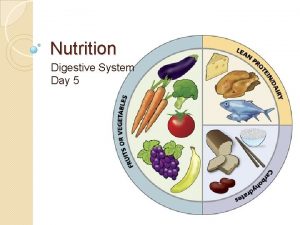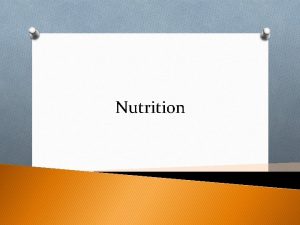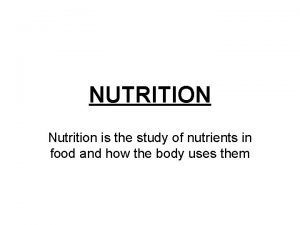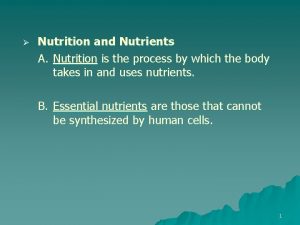Chapter 10 Nutrition for Health Lesson 2 Nutrients


























- Slides: 26

Chapter 10 Nutrition for Health Lesson 2 Nutrients for Wellness Click for: >> Main Menu >> Chapter 10 Assessment Teacher’s notes are available in the notes section of this presentation. Next >>

§ carbohydrates Sugars and starches that occur in foods, mainly in plants § fiber The part of fruit, vegetables, grains, and beans that your body cannot digest § proteins Nutrients your body uses to build, repair, and maintain cells and tissues § saturated fats Fats that are solid at room temperature

§ unsaturated fats Fats that remain liquid at room temperature § vitamins Substances that help your body fight infections and use other nutrients, among other jobs § minerals Elements that help form healthy bones and teeth, and regulate certain body processes

In this lesson, you will learn to § identify the six major classes of nutrients. § explain specific ways your body uses nutrients.

Organizing Information Make a diagram similar to the on below. Include a box for each nutrient and foods that are sources of that nutrient. Carbohydrates Food Sources Protein

Nutrients and Nutrition Carbohydrates Proteins Fats Vitamins Six Groups of Nutrients Minerals Water

Carbohydrates There are two kinds of carbohydrates: simple and complex. carbohydrates Sugars and starches that occur naturally in foods, mainly in plants

Carbohydrates All carbohydrates are made of sugar molecules. Simple carbohydrates Complex carbohydrates Molecules remain separate Molecules form long chains. Also knows as starches. Fruits, vegetables, milk products Grains, dried beans, and starchy vegetables such as potatoes Half to two-thirds of your daily energy should come from carbohydrates.

Fiber is a special type of complex carbohydrate found in raw fruits, vegetables, and whole grains. fiber The parts of fruit, vegetables, grains, and beans that your body cannot digest Eating high-fiber foods can help reduce your risk of certain types of cancer and heart disease.

Proteins are made up of chemical building blocks called amino acids. proteins Nutrients your body uses to build, repair, and maintain cells and tissues Proteins also play an important role in fighting disease because parts of your immune system are made of proteins.

Proteins Complete Proteins Plant Proteins Contain all nine of the essential amino acids Lack one or more of the nine essential amino acids Beef, pork, veal, fish, poultry, eggs, most dairy products Nuts peas, and dried beans

Fats Eating too many foods containing saturated fats can increase your risk of heart disease. saturated fats Fats that are solid at room temperature

Fats Most of the fats in your diet should be unsaturated fats Fats that remain liquid at room temperature

Fats Saturated Fats Unsaturated Fats Butter, cheese, fatty meats Plant foods such as olive oil, nuts and avocados

Cholesterol is a fatty substance found in the blood. LDL (low-density lipoprotein) HDL (high-density lipoprotein) Collects on the walls of arteries and forms plaque Removes LDL from the arteries Known as “bad cholesterol” Known as “good cholesterol” Eating too much saturated fat can increase the body’s level of cholesterol.

Vitamins and Minerals Vitamins and minerals are essential to your body’s health. vitamins Substances that help your body fight infections and use other nutrients, among other jobs minerals Elements that help form healthy bones and teeth, and regulate certain body processes

Vitamins and Minerals Vitamins Water-Soluble Fat-Soluble Not stored in the body Stored in the body Must be consumed regularly Stored in the body’s fat until they are needed. The best way to get vitamins and minerals is to choose nutritious foods.


Water Helps digest and absorb food. Regulates body temperature and blood circulation. Carries nutrients and oxygen to cells. Removes toxins and other wastes. Cushions joints. Protects tissues and organs from shock and damage.

Water Dehydration is a lack of water in the body. You need to replace the water your body loses by drinking at least eight 8 -ounce cups of fluid each day.

Lesson 2 Review What I Learned Vocabulary What is fiber? What function does it have in the body?

Lesson 2 Review What I Learned List Name the six major classes of nutrients.

Lesson 2 Review What I Learned Identify Name sources of complete proteins.

Lesson 2 Review Thinking Critically Apply Make a list of the foods you have eaten today. Identify which nutrients can be found in each food. Are there any nutrient groups that come up short?

Lesson 2 Review Thinking Critically Hypothesize How can the food you choose to eat today affect your health in the future?

End of Chapter 10 Nutrition for Health Lesson 2 Nutrients for Wellness Click for: >> Main Menu >> Chapter 10 Assessment
 Chapter 10 lesson 2 nutrients
Chapter 10 lesson 2 nutrients Chapter 10: nutrition for health lesson 1 answer key
Chapter 10: nutrition for health lesson 1 answer key Chapter 10 lesson 2 nutrients
Chapter 10 lesson 2 nutrients An overall state of well-being or total health
An overall state of well-being or total health Chapter 5 lesson 1 health
Chapter 5 lesson 1 health Chapter 10 nutrition for health vocabulary practice
Chapter 10 nutrition for health vocabulary practice Chapter 55 nutrition and health
Chapter 55 nutrition and health Lesson 1 the importance of nutrition
Lesson 1 the importance of nutrition Chapter 10 lesson 4 nutrition labels and food safety
Chapter 10 lesson 4 nutrition labels and food safety Chapter 5 nutrients at work
Chapter 5 nutrients at work Ul tolerable upper intake level
Ul tolerable upper intake level Nutrition in primary health care
Nutrition in primary health care Project title for health and nutrition
Project title for health and nutrition Public health nutrition definition
Public health nutrition definition Public health nutrition problems
Public health nutrition problems Introduction to public health nutrition
Introduction to public health nutrition Lesson 4 nutrition labels and food safety
Lesson 4 nutrition labels and food safety Unit 3 lesson 6 anorexia nervosa and bulimia
Unit 3 lesson 6 anorexia nervosa and bulimia Unit 3 nutrition lesson 4 weight control
Unit 3 nutrition lesson 4 weight control Myplate nutrition jeopardy
Myplate nutrition jeopardy Chapter 3 health wellness and health disparities
Chapter 3 health wellness and health disparities Chapter 1 lesson 2 what affects your health
Chapter 1 lesson 2 what affects your health Understanding health and wellness
Understanding health and wellness Fspos vägledning för kontinuitetshantering
Fspos vägledning för kontinuitetshantering Typiska novell drag
Typiska novell drag Nationell inriktning för artificiell intelligens
Nationell inriktning för artificiell intelligens Vad står k.r.å.k.a.n för
Vad står k.r.å.k.a.n för
